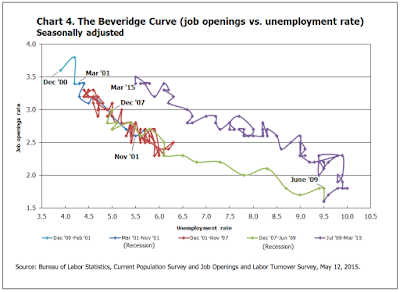A little-discussed graphical representation of the U.S. employment picture provides us with a very clear idea of just how different the recovery since the end of the Great Recession has been.
The Beveridge Curve is named after the British economic, William Henry Beveridge. Beveridge developed the British Unemployment Insurance Act and is considered one of the leading economists in recent history.
The Beveridge Curve graphically displays the negative relationship between the unemployment rate and the job vacancy rate over the course of a business cycle. During a normal economic expansion, the unemployment rate is low and the job openings rate is high. During a normal economic contraction, the unemployment rate is high and the job openings rate is low.
Here is a screen capture from the Bureau of Labor Statistics showing the unemployment plotted against the job openings rates in the current business cycle (in purple) and in past business cycles:
You'll notice that in the four economic cycles between December 2000 and June 2009, the curves lie on top of each other whereas, there is a significant shift in the current business cycle. Shine June 2009, the unemployment rate has been significantly higher when compared to the job openings rate. This suggests that the labor market is inefficient; in the period since the official end of the Great Recession and the present, there is a greater than normal divergence between jobs that are available and the unemployed who are looking to fill them. In other words, there is a significant mismatch in the job matching/job hiring process. This may suggest that, as millions of unemployed Americans know, that there has been a structural change in the American labor market that has not been overcome by trillions of dollars worth of Federal Reserve intervention.
Click HERE to read more of Glen Asher's columns
You can publish this article on your website as long as you provide a link back to this page.


Be the first to comment